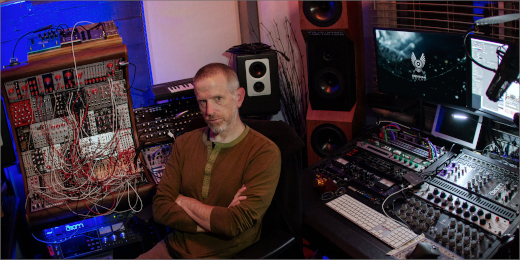Modular synthesis through yoga

CRT :: It’s been pretty amazing. Okay we were talking about Bill Laswell and Oz Fritz. That album is amazing just to listen to because it’s like..
Nathan :: Yeah. It’s like ethnomusicology.
CRT :: Yeah, exactly. It reminds me too Chad Mossholder.
Nathan :: Oh, I know Chad very well.
CRT :: Do you know Chad? Okay, good. His album Receiver (Somewherecold, 2020) reflects his work doing sound design for the DOOM videogames with a heavy bent towards sound design in the music. What you were saying about arranging sound reminded me of Chad. And also Dadub.
Nathan :: Oh! I love that guy’s stuff.
CRT :: I bring that up because it seems there’s that sensibility of both music and sound design merging. Now, going back to Nathan—I think you’ve already discovered my interview style involves talking a lot about me, which oddly enough, is very similar to my normal conversation style.
Nathan :: Having a mirror like this is fantastic, actually. It was way more comfortable than, “tell me this and tell me that.”
CRT :: Oh, good! Anyway, about Nathan Moody, of whom we were speaking. What was it like to have that realization while brushing your teeth? What was it like to go back into approaching music-making again? Was it difficult? Was there a growth period or something?
Nathan :: Getting back into making music was difficult for two main reasons. The first was all my musical chops had rusted, and I wasn’t really aware of what my voice was anymore. It took about three or four years of just putting in the hours and doing the work to even begin to figure out where my voice might now lie.
CRT :: Wow. I’m curious, were you releasing stuff in that period? Were you just woodshedding?
Nathan :: No. I was just making track after track and experimenting with technique and trying to find what was the mix of making me uncomfortable enough that I’m excited, and not so comfortable that I’m just repeating myself. Then, trying to find that middle ground.
CRT :: Oh. I totally get that.
Nathan :: The other really uncomfortable realization I made was that the first phase of me making music to be released was in order to fit in. It wasn’t because I have anything to say. I was trying to fit in with a certain scene that I realized only in retrospect, I left it because I felt too constrained by the strictures and standards of that scene, and how would it make music in a certain genre.
CRT :: Right.
Nathan :: It was a much harder path to follow in my second musical phase, because now I had to figure out why am I doing what I’m doing. What do I actually uniquely have to say and how? I didn’t have to think about that when I was making things that were strictly fitting in a certain genre and doing a certain scene.
CRT :: That’s fascinating. I’ll tell you, I’m kind of going through something similar. Now we’re going to talk about me, so I’m sorry.
Nathan :: I asked. I did.
CRT :: It’s funny because it mirrors what I went through in the early 90s. I’ve been making music since I was a kid, since 1984, but I didn’t play a lot of it for other people because I was terribly insecure about it. I couldn’t pay attention in lessons. My ADD really affected—and still does—sequential logic, which is essential in math or anything else that has to do that now. Interesting. Learning music was really difficult for me. 30 years later I’m like “oh, I could probably go back and learn some theory and actually learn to read and understand it,” because I know a better grasp of it, but also I’d be able to ask questions instead of sitting there quietly and hoping no one would notice me. What I tell people now is that I learned to understand modular synthesis through yoga.
Nathan :: Oh, interesting.
CRT :: Yeah my wife and I got really into Power Vinyasa heated yoga. Your end goal, if there has to be one, is sort of full relaxation of the body. In order to do that, you have to work the body in a specific sequence and a specific kind of pattern in order to free up the back, shoulders, hips, and the arms. You need the style of yoga, a class feeling fully worked over, like not a single inch of you hasn’t been rinsed and wrenched and put back in place.
So what I realized over time was that the way that style of yoga is put together you can say to a class “We’re working on shoulders today,” and you can put the poses together in a certain way to arrive at the end state of open shoulders. Or you do the same sequence day in, day out, day in, day out, day in, day out. After a year I started to understand how that applied to math, sequential logic, and then modular synthesis. I’m still very slowly creeping into. I began to realize “oh, there’s a sequence, and there is a way if you want to get to this point, you can,” but there’s, especially with modules, all of these different ways you can do it. Does that make sense? It’s like “All roads lead to Rome.”
Nathan :: Fascinating.
CRT :: Yeah, it was pretty cool to realize that. Now, I’ve completely forgotten why I asked you this, or why I brought this up. I guess because we were talking about how to fit in. What I’m going through now is similar to what I went through about 26 years ago. I, too, was really into industrial music, and I was doing a lot of stuff that was very heavily inspired by Cabaret Voltaire and Skinny Puppy, but also synth-pop like Depeche Mode, Ultravox, and David Sylvian. Just as I was graduating college in ’93 industrial music was really a rehash of what had been done the previous five or ten years.
Nathan :: Oh, my gosh yes.
CRT :: I was like, “Okay, I’m just going to make another song. There’s distortion on the bass, there’s distortion on the drums, I’m going to scream and I’m going to throw in this sample from a horror movie of Reagan.” And I was like, “This just sucks.” Then a friend of mine was in town playing. And that friend happened to be Moby. We’d gone to High School together, and we’ve known each other for a while. He was touring with Orbital, Vapourspace, and Aphex Twin.
Nathan :: Shit, dude! That is the show to be at!
CRT :: That was my Sex Pistols in 1976 at Manchester’s Lesser Free Trade Hall that like all the British bands talk about. It started me off on techno. I watched Aphex Twin playing behind a box where he’s got that Studio440 and like an MS-20 while onstage dancing is his friend Paul who’s incidentally also the guy who designed the Aphex Twin logo.
Nathan :: That’s crazy.
CRT :: Yep! I saw that and I said, “Okay, that’s the stuff I want to do.” I went through this period of maybe a year, of making really shitty techno and really bad stuff. Then, eventually, I found my sound and a couple years later started playing out. Took me an honest to god 12 years to get comfortable and confident enough to play out. Because I should say it here that I am a prickly son of a bitch when it comes to talking about my music and taking constructive criticism. I’ve gotten better but still prickly.
Nathan :: You didn’t get angry at my review of your album.
CRT :: Oh, no I loved it! And I’ll tell you what, there are a few people who I respect enough to want their opinions on my music. Because after 37 years of making music my knee-jerk reaction to anyone offering their opinion or criticize a work in progress is tell them to go fuck themselves. But a small group of people make me realize “Okay, maybe you should actually listen to this person.” That group is my wife Alice, my friends Jay and Kent and you.
A little while ago, Rob Galbraith (head of Component Recordings) said, “I want your next album to do something really different.” I’m like, “How so?” He said, “Well, try something different like maybe something with more hip-hop, or like straight up four-on-the-floor techno, or something that is like sound design, or organic sounds.” I’m like, “all right. I’ll think about it,” and I really spent several days brooding about it. Then I went back to the songs I’ve been working on and said “Oh, these suck! These are terrible!” It wasn’t until about two weeks later that I realized, “Oh, no. My style is changing again. Son of a bitch!”
Nathan :: It’s like going all the way back to square one, and it’s all over again.
CRT :: It is! Well, I thought I described it to someone as it’s like growing new skin.
Nathan :: Yeah. You’re molting.
CRT :: You are! And it’s horrible because you’re –
Nathan :: Very vulnerable.
CRT :: Yeah! You’re so vulnerable that like anybody with a toy piano and a laptop could make something better than you. You’re just garbage. And it didn’t help when he said straight techno I’m like “What do you mean?” He’s like “Well like this guy Shifted, who’s out of Germany.” I don’t know if you’ve heard of him but he’s fucking brilliant. His song “Moving Towards The Exits” I listened to 15 to 20 times in a row when I first heard it. Now you know me; I like a long song. I’m not afraid to let a theme or motif go on for 178 bars but I at least try to make it interesting. Yet Shifted is doing this compelling shit that made me not only think but want to dance, but it went from basic to otherworldly in about six minutes. And I’m like “God, yeah! Fuck!” Of course, being me, being obsessive, I hear that and immediately turn to my gear and start the programming something like a 909. And it’s shit, it sucked. I was telling my friend Kent and he’s like, “Well, you could stand to pull back a little bit, not release as much music.” I said, “First of all, fuck you, Kent. Secondly, you’re right.” I really did kind of pull back and start to look at stuff. And this was all transpiring in like a week or two. But I’m really feeling like I’ve been edging towards this next stage perhaps unconsciously and it’s like really coming about now.
But it’s God awful uncomfortable. Not sure I’m going to survive it but I’m still doing it because I know that for me, musically, if you care and you are conscious you don’t want to be treading the same ground over and over again.
<< previous page | next page >>

















![Allmanna Town :: 1911 EP (Self Released) — [concise]](https://igloomag.com/wp/wp-content/uploads/2025/03/allmannatown-1911_feat2-75x75.jpg)


